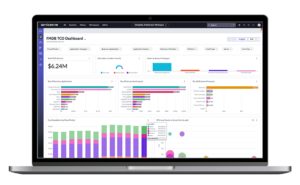Implementing ITFM/TBM software is a considerable investment, which is why organizations aim for a rapid deployment to realize positive ROI as fast as possible. Unfortunately, many implementations start strong but struggle to deliver enough long-term value to justify their cost — frustrating top-level management and leaving CIOs in an awkward, defensive position.
So, what can cause ITFM/TBM software to fall short of original expectations? Let’s take a look at six of the biggest reasons…
TBM Taxonomy Modification Risk
If you plan to base your initiative on TBM, you may need to modify the standard TBM taxonomy to suit your environment, and it’s critical that the software you choose can make those modifications safely and sustainably.
Because even though the TBM taxonomy can be tailored to an organization’s unique needs, many platforms won’t allow you to make material changes without increasing error risk, jeopardizing upgradeability, or conflicting with functionality elsewhere in the system — all of which threaten IT’s credibility and potential impact.
Before making any decisions, investigate your existing allocations and hierarchies very closely and note any potential conflicts with the standard TBM taxonomy; then ask potential vendors how your implementation could be impacted.
Small discrepancies may not pose any problems, but larger ones could seriously handicap long-term efficacy.
Vendor / Methodology Lock-in
Vendors often dictate a very prescriptive approach to ITFM/TBM, which naturally gets baked into their products. Consequently, organizations become increasingly obliged to stay with those vendors as their initiative matures.
Granted, this is a moot point if problems don’t arise and spur consideration of alternative systems; many organizations never hit roadblocks big enough to put their vendor relationship in question.
But if problems do arise, vendor lock-in makes migration an exceedingly expensive and time-consuming endeavor — forcing organizations to choose between “toughing it out” with their existing software or simply abandoning ITFM/TBM altogether.
As you court potential vendors, be sure to ask them one very specific question: how much has your methodology influenced the architecture of your solution? If you’re already partnered with a vendor but don’t know their potential lock-in risk, you’d be wise to educate yourself before continuing the relationship.
Sluggish Modeling Performance
The amount of value any ITFM/TBM software can deliver relies heavily on the integrity of its underlying cost model. And if your cost model can’t keep up with the pace of business — taking hours or days to produce usable outputs — the ultimate utility of the system will be severely limited.
For example, here are a few ways that a sluggish cost model can hold your initiative back:
- Delayed response time to stakeholders damages credibility.
- Model outputs are already ‘stale’ by the time they become available.
- Inability to rapidly iterate through multiple scenarios reduces the quality and velocity of decision-making.
Insufficient Granularity
Every decision requires a different level of detail, and only the decision-maker knows how much detail they need. Plus, IT leaders often must “show their work” to maintain credibility while interacting with stakeholders — again, requiring various degrees of granularity depending on the issue at hand.
That’s why having visibility into every possible layer of detail is so crucially important.
Unfortunately, many systems only deliver arbitrary, pre-defined levels of granularity — chosen at the vendor’s discretion and based solely on what they deem as typical user needs. The big problem here is that every user is different, and their needs are rarely the same.
That said, while many solutions are built on the assumption that full visibility is potentially overwhelming or simply unnecessary, many organizations can’t accomplish their goals without it.
Non-Configurable User Views
All modern ITFM/TBM software offers a pre-built collection of targeted views for specific users and stakeholders. However, these views don’t always work as intended, either failing to deliver what stakeholders truly need or forcing them to navigate a sea of complexity in a less-than-intuitive interface.
When stakeholders can’t quickly glean insight from a solution, or worse, if they don’t understand how to use it at all, driving adoption across the business will always be an uphill battle — putting the entire initiative at serious risk of abandonment.
Clearly, the best way to remedy this problem is to give users the freedom to clone and reconfigure out-of-the-box views as they see fit. But surprisingly, that capability isn’t a common one among existing solutions in the market.
Database Restrictions
One of the biggest benefits of dedicated ITFM/TBM software is the ability to aggregate all available data and leverage it through automated analytics. But having your data validated and housed in a single source-of-truth is a huge potential value-add by itself.
Even without automated analytics, having access to a clean, complete data set opens up a world of possibilities — but only if that data is accessible.
Unfortunately, most solutions keep their databases locked away and out of reach, keeping analysis constrained to the solution’s proprietary logic and built-in assumptions (neither of which are visible or editable by the user).
Safeguard Your Organization from a Stalled Implementation with Nicus
Investing in ITFM/TBM shouldn’t be a high-risk, high-reward proposition. That’s why we’ve addressed each of the pitfalls you’ve read about here in the upcoming release of Nicus 6.0 — while including several other key upgrades we believe to be critical for success (like an AI-powered insights discovery engine).
To learn more about how Nicus 6.0 can help assure positive, long-term ROI from your ITFM/TBM program, reach out today to start the conversation.





